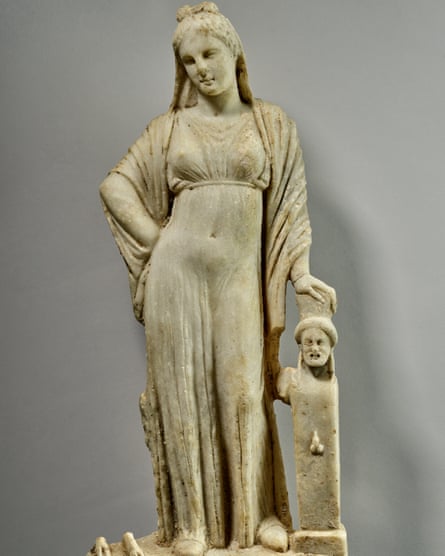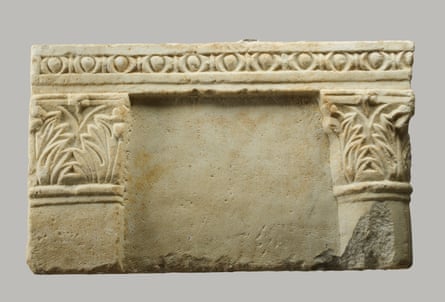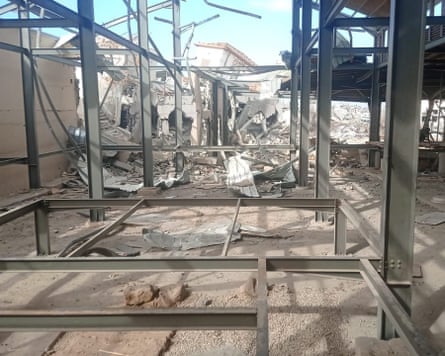An exhibition tracing more than 5,000 years of cultural and archaeological history in Gaza has become a summer hit in Paris, as visitors flock to discover the heritage of this strip of land along the Mediterranean, whose multilayered past has been eclipsed by modern tragedy.
While Gaza faces a humanitarian catastrophe of starvation and war, the exhibition, Saved Treasures of Gaza, at Paris’s Institut du Monde Arabe brings what curators called a sense of “urgency” to explain the rich history of a place that has been a crossroads of cultures since Neolithic times.
For thousands of years, Gaza’s location on the eastern Mediterranean made it a prosperous oasis. It was a trade hub, intellectual powerhouse and centre of learning, sitting at one of the world’s great geographical crossroads between trade routes from Asia and Africa. Many cultures and empires left their mark – including Philistines, Assyrians, Romans, Byzantines, Persians and Mamluks – as depicted by more than 100 intricate objects on display from statuettes, oil lamps and ceramics to inscriptions, imported marble and a vast Byzantine floor mosaic.
“We wanted to give Gaza its history back,” said Élodie Bouffard, the lead curator. “It was about restoring the humanity of Gaza and making its long history visible again, rather than reducing it to a discourse dominated by contemporary history. The focus on contemporary history risks depicting Gaza as a zone of tragedy, a bubble where only devastation is possible, when in fact there is a long human history in Gaza built upon thousands of years as a great centre of connection.”
Bouffard said: “Gaza was the most open space in the Mediterranean. It was a territory that was extremely rich, that produced a lot of food and whose connections to Africa and Asia made it a place of festival and celebration that was much talked about and written about, and a place that was continually inhabited.”
The pieces on show have been largely locked away in storage in Switzerland for 17 years: after an exhibition in 2007 at Geneva’s Museum of Art and History, the works could not be safely returned to Gaza because of the security and political situation.
“Their exile saved them in a sense,” said Bouffard, noting that otherwise they could have been lost in the current Israeli bombardment. But she said this also meant the pieces had mostly been sadly “hidden and locked away from view” and from public understanding.
One of the key pieces in the show is a small marble statue of a goddess, thought to be either Aphrodite or Hecate, dating from the Roman or Hellenic era, who would have once sat in a temple.
Bouffard said the statue’s fate is symbolic of the layers of history and archaeological challenges in Gaza. “She is a masterpiece. She must have disappeared during the forced Christianisation of Gaza in AD402-AD405, taken from her alcove in a temple. She was maybe thrown into the sea, where she disappeared for 1,500 years, until a fisher found her off Blakhiya, a neighbourhood that has now been destroyed. He chose to give her to a Palestinian collector – so she was saved.”
Bouffard added: “Then she was brought to Europe, shown in Geneva in 2007, just as an effort was being made to raise funds to create an archaeological museum in Gaza. No museum has been built in Gaza and she has never gone home. Hers is a story of many tragic moments of appearing and disappearing … She looks at us and is still waiting to return to the place where she was created.”
The Paris exhibition also traces archaeological excavation work in Gaza and the sites of cultural and historical significance damaged in military strikes since 2023, including mosques, churches, archives and the archaeological site of Anthedon harbour, Gaza’s first known seaport.
Bouffard said this was not to suggest heritage sites were more important than human lives: “Between old stones and humans, it is always humans who are the priority.”
But she said that learning about thousands of years of history that had connected people was a way to bring perspective and potential hope. “If history is not spoken about, then the discourse focuses on a feeling there is no solution,” she said.
Jack Lang, the head of the Institut du Monde Arabe and a former French culture minister, said at the exhibition’s opening that he hoped the show could “restore some hope in the future of Gaza”.
He said: “Nothing is worse than abandonment and forgetting.”
-
Saved Treasures of Gaza is at the Institut du Monde Arabe, Paris, until 2 November











